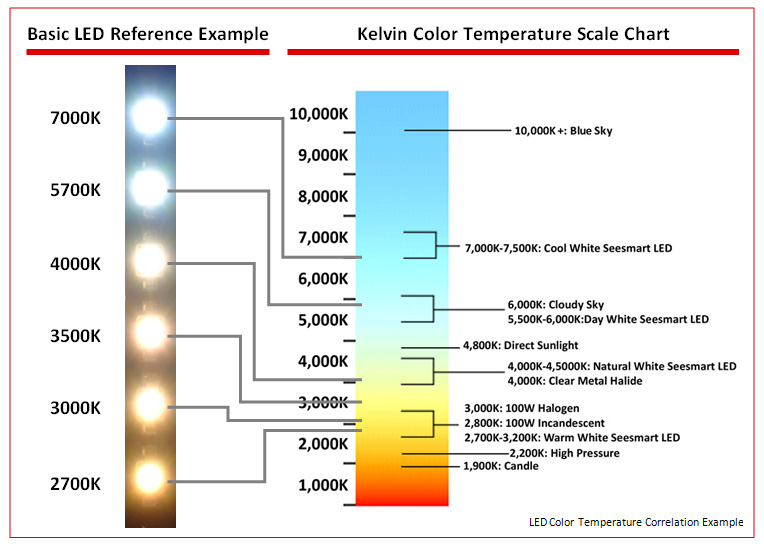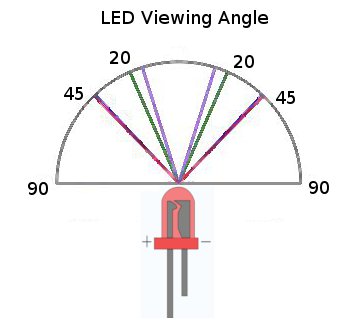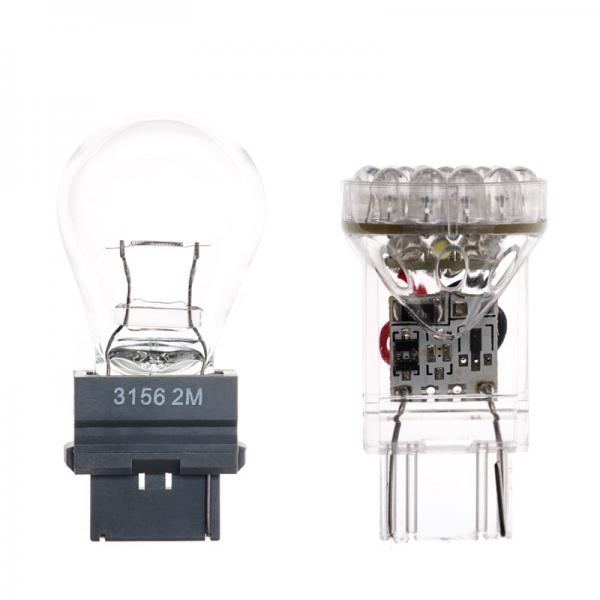| PM | Quote | Reply | Full Topic |
Gunslinger
Joined: Sat Nov 4th, 2017
Posts: 426
Status:
Offline
Reputation: 











Reputation Points: $user_rep
But first, the ever important disclaimer. Source materials don't always agree with each other, so it's very possible you will find charts or other sources which will disagree or conflict with what I have. What I have laid out here is based on my experience and what I have learned, and what I have found to be the most accurate. That being said, let's continue.
Right away you will notice that there are several more options when choosing LEDs vs incandescent replacements. Lumens, kelvin rating, polarity, viewing angle, etc. What do these words mean, and what options should I select?
Lucky for you, these options are fairly straight forward and easy to understand. Let's start with the all-important kelvin rating.
Kelvin (K) is a measure of 'temperature', usually ranging from 1,000k to 10,000k and everywhere in between. The system is derived from what color steel appears to glow at a given temperature in kelvin. You will see this same system being used on the backs of CFL and LED bulbs you can buy in the stores.
So, what does glowing steel have to do with bulbs? This range of measurement is used to tell the consumer what color 'light output' to expect from a "white" bulb. You may have noticed that some bulbs, although called 'white' aren't necessarily white, and usually have a color cast.
For example, a 2500k to 3000k rated lamp should give a color close to that of tungsten from traditional bulbs. 4500k to 5000k is very close to daylight, and 6000k+ goes further and further into the 'cold' or 'blue' range. I've added a chart to help illustrate the idea.
Note: For colored bulbs (red, yellow, or blue, etc) you will not find a Kelvin rating. This applies only to 'white' bulbs.

So, what are 'lumens'?
Lumen(s) is a measure of brightness or intensity. Sounds cut and dry, right? Well, kind of. One lumen is said to be equal to the brightness of a single candle, so 20 lumens = 20 candles. Your typical 194 bulb, such as those used in the gauge cluster, are around 25-30 lumens. This will vary depending on what brand you buy, how old they are, and if they're the special high-output 194s, but generally speaking they're around 25-30 lumens. If you're seeking to compare brightness between an incandecent and it's LED replacement, search for "194 lumens" or "3157 lumens", for example. You will generally find a source where someone has accurately estimated the intensity of a given bulb.
That's all well and good for white bulbs, but a bit of trouble comes in when lumens are measured on colored bulbs. The devices used to measure these operate on the entire spectrum of visible light, and LEDs of a specific color will only produce a very narrow wavelength correspondent to the color they're labeled as, making a blue LED rated at only 15 lumens sound not too impressive, when in reality it's much brighter than that. Unfortunately, I haven't seen anyone come up with a system that accurately reflects brightness of colored bulbs, so the most that can be said about those is, use your best judgement. Also realize that some colors will appear brighter than one another, green being more intense than red for example. What I will recommend though is to get a brighter bulb than you think you need, much in the same way as you would cut a longer length of wire than what you measured. LEDs can always be dimmed, or dialed in, so consider that as well.
Polarity. Many of you should be already familiar with this concept, but it's worth going over. If you've ever changed a normal bulb in your car, you know that it doesn't care which way it goes in the socket, as it will work no matter what way it's flipped. LEDs, on the other hand, don't always behave this way. LED stand for Light Emitting Diode, and diodes only work going one direction. If plugged in backwards, they simply don't work. Some bulbs have circuitry inside them to get around this, most don't. Have a friend help you test your new LEDs before buttoning the fixture back up to ensure that the new lamps work. If it does not work, rotate the bulb 180 degrees and try again.
Viewing angle. This one is a little more complicated, but not by much. As we know, incandescent bulbs throw light all around them by their very nature, much like a flame. LEDs do not behave in the same way, and it's important to know which is most appropriate for a given application.
Viewing angle is measured in degrees, ranging from 0 to 360, a unit most of us should already be familiar with. In this context, we're measuring how wide the LED's light output is. 15 degrees would be very narrow, like a spotlight, where as 360 degrees behaves like a tungsten bulb. Again, I have provided a diagram for those who would like one.

So what would be appropriate for a given application? Dome lights, usually without a reflector, are served well by a narrow viewing angle, aimed in the general direction that is desired. Brake lights and indicator lights can be served well by both narrower and 360 degree viewing angles, with a caveat. If the housing used does not have a reflector, or if it is very poor, (IE, flaking chrome), a narrow beam directed out of the fixture is most appropriate. Vehicles with reflectors installed can be served by both, but would be best served by 360 degree style bulbs, especially more exotic lenses which have specially designed reflectors to create patterns. Inspect yours to see what best suits you and your application.
One other thing you will see in choosing LEDs is that some appear to be different. Some LEDs will have a bunch of clear or colored nubs on them, and others will have yellow and white bits going around them. What you're seeing is the type of LED used, either 'through hole' or 'SMD'. Through hole means that the pins of the LED go through the board and are soldered in place. SMD stands for Surface Mounted Diode, and as the name implies, is soldered directly onto the surface.
Of course that brings up the 'which is better' argument, which is easily summed up. Both do their jobs very well, although you will generally see the SMD style LED is used for the brighter lamps. I have provided images of a 'through hole' style 3156/3157 and an SMD style 194/921 style bulb for visual purposes. 194/921 on top, 3156/3157 on bottom.


While we're talking about special types of LEDs, there are three other things I should mention.
First, you may see the term "COB" be used. This means 'chip on board', and are usually used for the brightest application, usually used with the brand CREE. They take the form as a big yellow spot on various positions of the bulb, like this one.

Second, did you notice that lens on the top of that bulb? These are often used in conjunction with COB bulbs to produce light that is brighter and goes farther, being very focused, much like a projector headlight. As a result, however, these can be 'oversize' so ensure they fit in where you're putting them before you buy. Many oversize bulbs can be found, so make it a habit to measure the size bulb that will fit first. A pencil and sharpie can be used to great effectiveness to determine depth.
Third, you may run across 'error free' or 'CAN BUS' type LEDs. These bulbs are special, and are designed not to interfere with some vehicles which tell you when a bulb is out. If normal LEDs are installed in these cars, you can get several codes for burned out bulbs. CAN BUS leds should not be used in applications that do not have this ability. The Ranger does not have CAN BUS.
There are a few other things worth mentioning in general, so hold on.
First, you can find these LEDs on ebay from china, but beware of these. The 194/921 bulbs do not last long at all in a vehicle, but work fine for landscaping. However, the 3156 and 3157 type bulbs seem to work just fine. I highly recommend you visit superbrightleds.com for purchasing the bulbs you want. You do pay a premium, but you're buying quality bulbs that last, and every bulb has a dedicated spec sheet that tells you everything you need to know before you buy, whereas most sellers on Ebay leave that important information out. All the terms I've gone over will be made use of, plus a few more to give you the best chance of finding what you want. I am not affiliated with superbrightleds in any way, but I am very satisfied customer. Check them out, and be thankful you did.
Second, beware of LEDs from anyone made for headlights or fog lights. The DO NOT work well at all, and there is a reason for that. Unlike indicator lamps, headlights and foglights have reflectors that are precision designed around the placement of the filament inside the housing. These LED bulbs are not technologically advanced enough to coincide with these measurements, thus performance is severely reduced. If you want an easy swap for these, I recommend the Nighthawk or Silverstar lines of bulbs. I personally use Nighthawk, my father uses Silverstar. Both can be found for much cheaper on amazon than you would in store.
Third, I'm going to list off the bulbs that the Ranger uses in it's STOCK configuration, from the factory, excluding headlight and foglight bulbs. I am unfamiliar with pre-98 Rangers, so I would appreciate someone who is familiar telling me what they have.
98-00
Front: Two 3157s & one 194 per side.
Rear: One 3157, two 3156s, & one 194 per side. *Year model 2000 uses One 3157, one 3156 & one 194 per side*
Interior: Six 194s in gauge cluster - main backlighting *Idiot lights use #74 bulb*
HVAC panel uses two 194s *Some models use #74. Remove to ensure correct bulb fitment*
Dome assembly: One 4140 / 578 FESTOON & Two 194 - 921 -OR- one 194 - 921. Remove fixture to ensure fitment.
Glovebox & Ashtray (if equipped): One 194
Cargo/Third Brake Assembly: Three 921 with cargo lights, One 921 with brake lamp only.
Underhood: 194/921 when installed.
01-11
Front: One 3157 & one 194 per side.
Rear: One 3157, one 3156 & one 194 per side
Interior: Six 194s in gauge cluster - main backlighting *Idiot lights use #74 bulb*
HVAC panel uses two 194s *Some models use #74. Remove to ensure correct bulb fitment*
Dome assembly: One 4140 / 578 FESTOON & Two 194 - 921 -OR- one 194 - 921. Remove fixture to ensure fitment.
Glovebox & Ashtray (if equipped): One 194
Cargo/Third Brake Assembly: Three 921 with cargo lights, One 921 with brake lamp only.
Underhood: 194/921 when installed.
NOTES
1. 194/921 style bulbs are interchangable one way while incandescent, two way in LED form.
When incandecent bulbs are used, a 194 can be used in place of a 921, but a 921 cannot be used in place of a 194. 921s are larger, brighter, and run hotter.
2. A 3157 (dual filament) can be used in place of a 3156 (single filament), but not the other way around.
3. It is best to use a colored bulb through a colored lens, IE a red bulb for a red lens, an amber bulb for an amber lens. You will have richer colors if you do, rather than a mildly washed out color.
4. If you are planning on using LEDs for turn signals, you will need to replace your existing flasher unit with an EP27, available from multiple retailers both online and local. If you do not use one, you may find the signal may flash too fast or not at all.
Last edited on Sat Nov 25th, 2017 02:09 pm by TheArcticWolf1911
____________________
1999 Ford Ranger XLT - 3.0 V6 4x4 - Loaded (Totaled) 143k. Rest in Peace, Gold Dust.